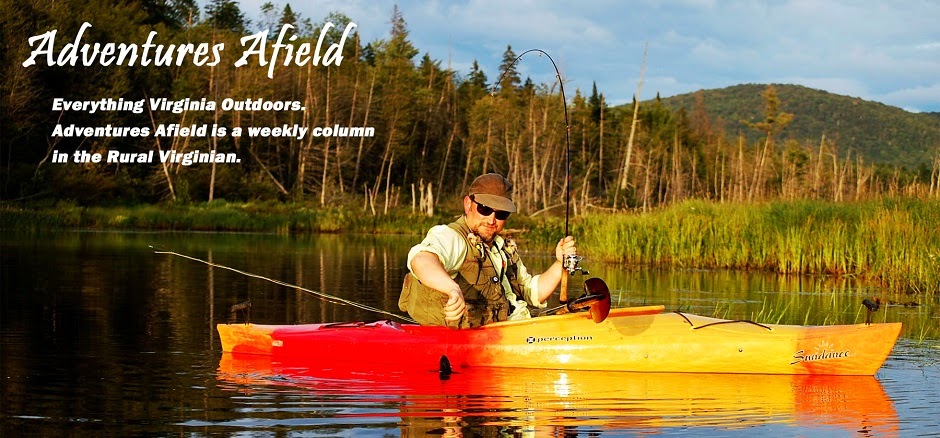The temperatures and the
sky have confirmed that we are well into the “Dog Days” of summer.
The Players
Several species of sunfish inhabit Virginia waters,
and are readily available to the angler.
Redear, redbreast, pumpkinseed, and bluegill all sport names equal in
simple flare to their character and habits.
.jpg) |
| A hard-fighting, bottom-feeding redear on the fly. Photo by Matthew Reilly |
Redear are the lone bottomfeeders of the scrappy
bunch, and thus tend to age larger and meaner.
They prefer cleaner lakes and ponds with plenty of bottom cover, where
they can be caught with bottom rigs as they feed on small shellfish, worms, and
insects.
The similarly-named redbreast sunfish are primarily
stream dwellers, and are common catches on rivers such as the James, Rapidan,
and Rivanna. Skinny, shaded water along
river banks and grass beds suit these characters best, and are usually smaller
than their stillwater cousins. Small
spinners, grubs, and poppers fished in prime habitat are choice lures for these
fish.
The pumpkinseed and bluegill often inhabit the same
waters, feeding on small crustaceans, insects, and worms. Both too remain very active in the heat of
the summer, though pumpkinseed have a higher tolerance for sunlight and will
dwell in shallow, sun-lit coves throughout the day, while bluegill will migrate
to escape the sun during the day before and return to the shallows in the
evenings.
The Locations
 |
| A hefty bluegill taken from a mill pond. Photo by Matthew Reilly |
To view a patch of the Piedmont from the sky, what
appears is an expanse mottled green and tawny—forest and farmland—marbled with
the varied pockets of blue, black, and brown.
No farm pond is the same; and that uniqueness in water qualities is what
is most striking about each appearance. Rich,
rocky, wooded ponds reflect black; pebbly, pure, spring-fed impoundments show
blue; and meadow farm ponds are muddy brown—all hold panfish.
Rivers broad and narrow slither across the state in
their journey to salt, and they, in the slow stretches and the powerful runs,
too hold panfish. The creeks and streams
that undermine your drive to work or school, with a depth measured in inches,
also hold panfish.
Almost any piece of water, from the mountainous
highlands to the meandering cypress swamps of the Tidewater, all hold panfish,
where they are easy to catch and, often, plentiful.
The Tackle
If you can remember your first fish, chances are it
was a species of sunfish. If so, you’ll
probably also remember the desperate fight that dunked and enlivened a red and
white bobber placed within reach of the greedy sunnie.
Greed in the case of the sunfish is probably the
foremost cause for their reputation as easy targets.
Coupled with the natural association of a
bobber and nightcrawler, the sunfish are often neglected by those fishermen who
have come of age, but have moved on to “bigger and better” things. That’s good for those of us who value our
pride, but sacrifice nothing in indulging in some good old-fashioned
“perch-jerking.”
 |
| An ultra-light spinning combo, 4-lb mono, and a black Joe's Fly make up the author's favorite sunnie rig. Photo by Matthew Reilly |
The gear required is simple. An ultra-light to medium rod spooled with two
to four pound monofilament is enough to handle most fish.
In
many cases, a simple clip-on red and white bobber or foam peg float is
practical, but in the event that you find yourself fishing deeper water, I
recommend investing in floats that utilize bobber stops to minimize casting
issues.
This, topped with a snelled baitholder hook, size
four—or two, for smaller fish—loaded with red wigglers, crickets, mealworms, or
small crayfish or minnows is deadly.
For those “above”—eyes rolling—bobber fishing, or for
those that just want an added challenge, sunfish will readily take artificial
lures and flies.
 |
| From left to right: Joe's Flies, Mepps Spinners, and Panther Martins are all great panfish lures. Photo by Matthew Reilly |
Beetle Spins, Panther Martins, Mepps spinners, Roadrunners,
and my favorite, Joes Flies all have their place in the panfishing world. Small grubs in white, yellow, and natural
olive and brown colors; shad spoons; and the simple yet effective Trout Magnets
also take their share of sunnies, both in still and moving waters.
Fly anglers should fish small nymphs, wet flies, dry
flies, and flashy streamers. My favorite
technique is casting a small, thinly-dressed popper to underwater grass beds in
July and August. On an average day,
shooting fish in a barrel would be tougher, and much less fun!
Availability, excitement, and a willingness to bite,
even during the Dog Days of summer, all combine to make the sunfish quality
fish worthy of your time and efforts. So
sit back, relax, and search for some sunnies this summer. Heck, even keep a few. They’re called panfish for a reason!
First published in the Rural Virginian



